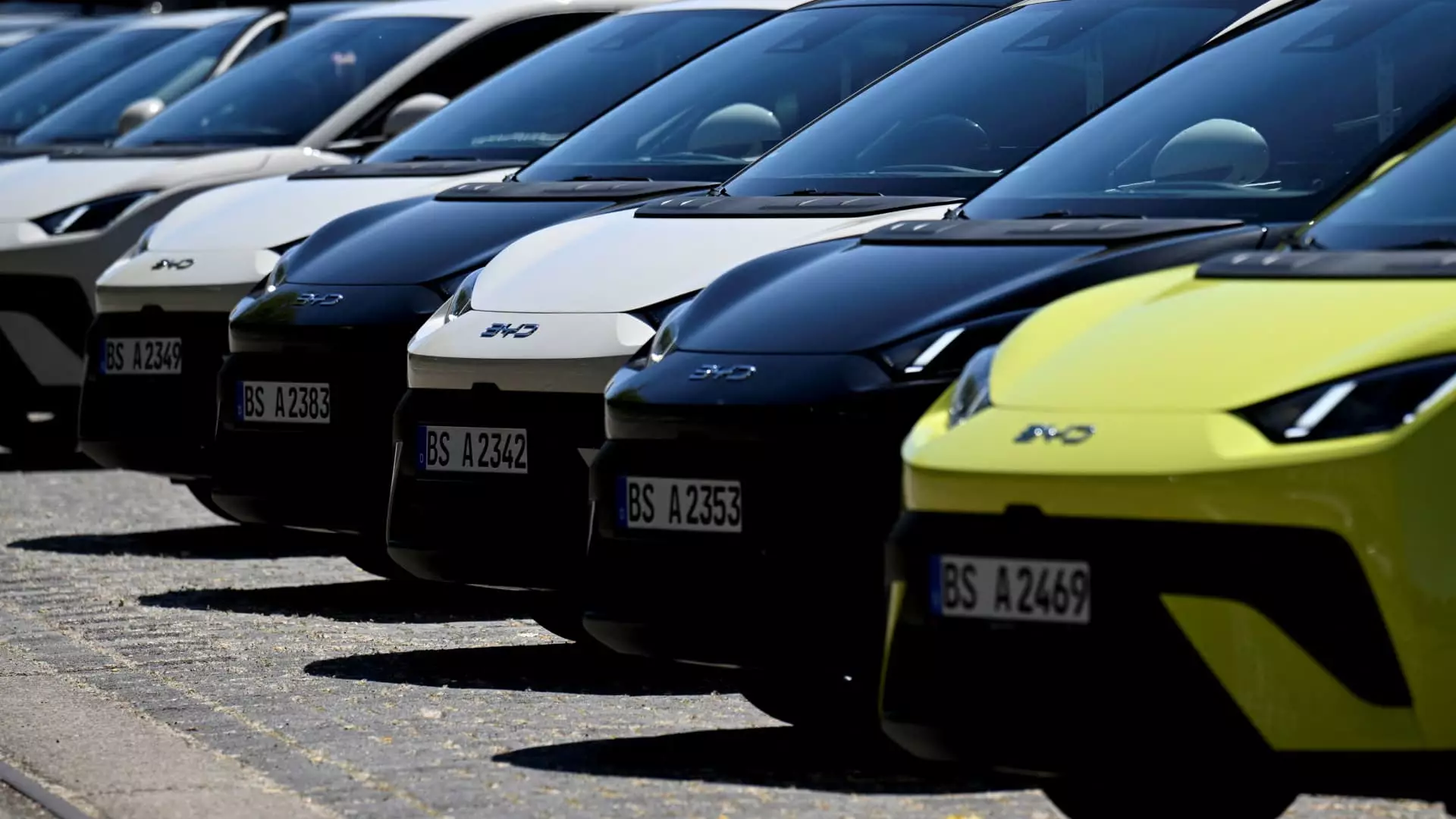China’s electric vehicle (EV) market, once a beacon of innovation and growth, now finds itself embroiled in a fierce price war that may redefine the landscape of the automotive industry as we know it. The recent sharp decline in Tesla’s sales as reported by the China Passenger Car Association—a staggering 15% drop in May compared to the previous year—reflects not only the volatile nature of consumer preferences but also the intense competition amongst electric vehicle manufacturers within the world’s largest automotive market. In stark contrast, BYD has reported a modest 14% sales increase, yet even this seemingly positive figure reveals an alarming need for substantial discounts to stimulate demand.
This convergence of competing narratives suggests an unsettling trend: survival now hinges as much on pricing strategies as it does on innovation. As seasoned investors wager on which companies will emerge unscathed or even thrive in this climate, it becomes evident that the concept of ‘price war’ is no longer a mere marketing strategy but a survival tactic in an oversaturated market. The once undaunted giants of the EV sector are now grappling with the bleak possibility that only the nimble and astute will survive.
An Investor’s Nightmare?
The market analysts are at odds—while CLSA has high hopes for BYD, labeling it an “outperform,” there lies an undercurrent of skepticism as sales targets remain elusive. The 20% upside projected for BYD’s shares serves to highlight the disparity between expectation and reality. Geely, identified as “best positioned” by analysts due to its optimal internal structure and competitive pricing, stands in stark contrast. This complex web of projections paints a picture of uncertainty, revealing that what might look good on paper could inherently possess fatal flaws when faced with real-world challenges.
When we look at Geely’s strategy, which revolves around a diversified portfolio that includes brands like Galaxy and Zeekr, one has to marvel at its adaptability. Yet, this very adaptability exposes a fundamental volatility. The underlying question persists: Are investors betting on innovation or merely on survival tactics designed to appease shareholders in a shaky economy?
The False Light of Stability
Leapmotor and Li Auto, both considered somewhat stable amidst chaos due to their strong delivery numbers, embody yet another layer of complexity. The fact that Li Auto has managed to maintain profitability in a quarter marked by industry-wide turmoil exemplifies a rare resilience, yet it raises eyebrows about sustainability. Although analysts predict growth for Li Auto based on its premium SUV lineup, the ever-looming specter of head-to-head pricing competition casts shadows over every optimistic forecast.
Experts assert that “volatile markets breed volatile companies,” and this could be an apt descriptor of the current situation. Investors may rejoice at the thought of a “better-than-feared” first quarter for these companies, but the reality is that consumer sentiment and demand dynamics can pivot with relentless speed. The quest for a competitive edge through price cuts betrays a deeper concern: are these companies truly innovating, or are they merely participating in a high-stakes game of chicken, waiting for someone to blink first?
The Storm’s Aftermath: What Comes Next?
As the industry shakes, bullish narratives touting BYD’s potential for growth through overseas expansion clash with the cautionary tales of impending market saturation and overproduction. The apprehension surrounding the influx of low-cost EVs into Europe stirs up nightmares of tariffs and regulatory hurdles, adding yet another layer of uncertainty to the equation. Analysts’ projections anticipating that BYD’s overseas market share will contribute to over 40% of its earnings by 2025 come forth as a glimmering yet fragile hope.
The underlying question of sustainability persists, as the interplay between supply, demand, and competitive pricing begins to unearth broader economic implications. Macquarie’s assertion that the current price war could ultimately resolve itself through simple economics underscores a critical truth: the laws of supply and demand are unforgiving. If production capacity massively outstrips demand, a reckoning will arrive—not with gentle nudges, but with a harsh and unforgiving reality.
The Hidden Costs of Price Disparity
The veneer of cheap electric vehicles masks a complicated interplay of manufacturing and operational odds. The price war, while seemingly beneficial to consumers in the short term, could result in a plethora of hidden costs in the long run as companies strive to maintain unsustainable pricing models. Discounting may drive unit sales but does it solidify customer loyalty, or merely cultivate a culture of waiting for the next best deal?
In an environment where “cheap” becomes the uncompromising norm, quality often takes a backseat. Encouragingly, the marketplace still craves innovation, technical prowess, and brand dedication—traits which, if diluted by relentless price competition, risk undermining the very industry that once promised revolutionary change in how we drive and energize our lives. The trick is finding the balance, and currently, it appears that balance is teetering on a precarious edge.

